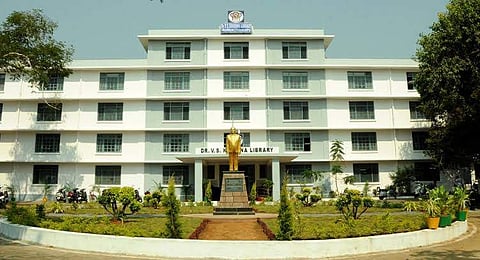

A treasure trove of etchings on 'Tala Patras' (palm leaves), at the 93-year-old Dr VS Krishna Library of Andhra University in Visakhapatnam are all set to be digitised. The 60,000 sq ft library is a repository of lakhs of rare books and 2,663 palm leaf manuscripts in five languages by more than 300 authors, enshrining the ancient Indian knowledge and culture, covering different disciplines including Ayurveda, arts, religion, astronomy, medicine, law and agriculture.
Most of the palm leaf manuscripts here are said to be illegible, except for their cover pages/titles, and are considered to be invaluable teachings for researchers, scholars, political science students and the public once digitised. The manuscripts include the oldest Parashar Smriti, authored by sage Parashar; Dasarupaka and Rupaka Paribhasha of Natya Sastra, the earliest literature on music and drama written between 500 BCE and 500 CE by sage Bharata, at least as far back as the Natasutras.
The University had previously entered into an MoU with the National Mission for Manuscripts, but it is now carrying out the due process and looking into ways to conserve the scripts from getting lost in time, with funding from the Higher Education Development Scheme Rashtriya Uchchatar Shiksha Abhiyan (RUSA).
Informatics Publishing Limited, a Bengaluru-based e-publishing company, won the tender to digitise the manuscripts in the period of a year. A team of 6 outsourced professionals from Bengaluru reached the city and kickstarted the project on December 27 at the library.
The team said that their target is to complete the digitisation process of these pieces within 6 months, even earlier than the specified time. Speaking to TNIE, M Jagannath, Senior Manager, Informatics, said, "Many of these tala patras' roots trace back to the Gutenberg era. Each and every script has been safeguarded in a reference room of the library since ages. Now, this project will help the library in serving its purpose: conservation and dissemination of knowledge and information on ancient Indian culture and arts."
The process starts with cleaning of the brittle palm leaves and layering them with lemongrass oil before scanning and digitising the manuscripts using a high quality production scanner to retrieve the scripts entirely. A team of linguists and subject experts will work on transcribing and subject classification. The digitisation project is also expected to reveal evidence about the origins and other details of many manuscripts, he informed. After the completion, the texts with their respective authors' names and subject areas will be uploaded on the AU's official website.
The University Librarian, Professor P Venkateswarulu, opined that it would enable scholars and a wider audience from around the world to read and understand Indian art, culture and heritage better, thereby giving a push to the research.
A digital repository is being developed to make the manuscripts available to future generations at just a click away. Started in 1927 and rechristened Dr VS Krishna Library in 1968, the library safeguarded tala patras donated by the former kings of Vizianagaram and Zamindars of Srikakulam, aside from the collections of founding Vice-Chancellor CR Reddy.
It also has in its possession the manuscripts featuring Sanskrit shlokas and ancient traditions, said to have been written in the 15th century. The library houses a rare collection that comprises pieces such as Chanakya's Arthashastra, the Mahabharata, editions of Valmiki's Ramayana, Kalidasa's Raghuvamsa. Ramanuja's and Adi Sankara's commentaries written in Pali, Sanskrit, Tamil, Bengali, Kannada and Telugu.
